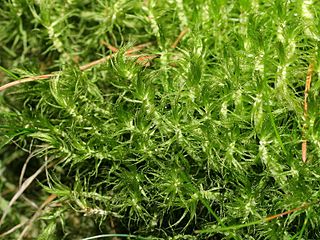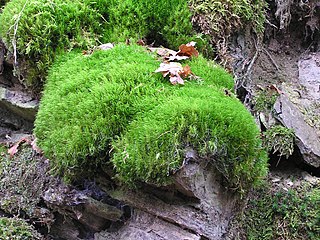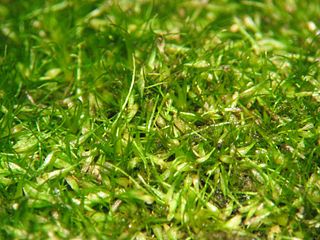
Dicranum is a genus of mosses, also called wind-blown mosses or fork mosses. These mosses form in densely packed clumps. Stems may fork, but do not branch. In general, upright stems will be single but packed together. Dicranum is distributed globally. In North America these are commonly found in Jack pine or Red pine stands.

Aconitum napellus, monkshood, aconite, Venus' chariot or wolfsbane, is a species of highly toxic flowering plants in the genus Aconitum of the family Ranunculaceae, native and endemic to western and central Europe. It is an herbaceous perennial plant growing to 1 m tall, with hairless stems and leaves. The leaves are rounded, 5–10 cm (2.0–3.9 in) diameter, palmately divided into five to seven deeply lobed segments. The flowers are dark purple to bluish-purple, narrow oblong helmet-shaped, 1–2 cm (0.39–0.79 in) tall. Plants native to Asia and North America formerly listed as A. napellus are now regarded as separate species. The plant is extremely poisonous in both ingestion and body contact.

The wood lemming is a species of rodent in the family Cricetidae. It belongs to the rodent subfamily Arvicolinae, so is a relative of the voles, lemmings, and muskrats. It is found in the taiga biome of China, Estonia, Finland, Mongolia, Norway, Russia, and Sweden.

Onopordum tauricum, the Taurian thistle or bull cottonthistle, is a species of thistle. It is native to Eurasia and is known in Australia and the western United States as an introduced species. It easily becomes a noxious weed, similar to its relative, Onopordum acanthium.

Dicranaceae is a family of haplolepideous mosses (Dicranidae) in class Bryopsida. Species within this family are dioicous. Genera in this family include Dicranum, Dicranoloma, and Mitrobryum.

Eudonia murana, the Scotch gray or wall grey, is a moth of the family Crambidae. It was described by John Curtis in 1827 and is found in most of Europe.

Dicranum scoparium, the broom forkmoss, is a species of dicranid moss, native to most of the northern hemisphere as well as Oceania. It usually forms tufts or mats on soil in dry to moist forested areas. As with many types of moss Broom moss grows in clumps with Broom mosses as well as other mosses. It can be distinguished by its leaves, which strongly curve to one side.

Olethreutes palustrana is a moth of the family Tortricidae. It is found in most of Europe, except the Iberian Peninsula and the Balkan Peninsula. It is also known from the eastern part of the Palearctic realm and North America. The habitat consists of heathland with scattered trees.
NVC community W17 is one of the woodland communities in the British National Vegetation Classification system. It is one of the six communities falling in the "mixed deciduous and oak/birch woodlands" group.

Aconitum tauricum is a species of flowering plant in the buttercup family. Some sources declare it as a subspecies of Aconitum napellus under the name Aconitum napellus subsp. tauricum.

Dicranodontium denudatum is a species of moss belonging to the family Dicranaceae.
Dicranum drummondii is a species of moss belonging to the family Dicranaceae.
Dicranum leioneuron is a species of moss belonging to the family Dicranaceae.
Dicranum spurium is a species of moss belonging to the family Dicranaceae.
Dicranum viride is a species of moss belonging to the family Dicranaceae.

Dicranum majus is a species of moss belonging to the family Dicranaceae.












